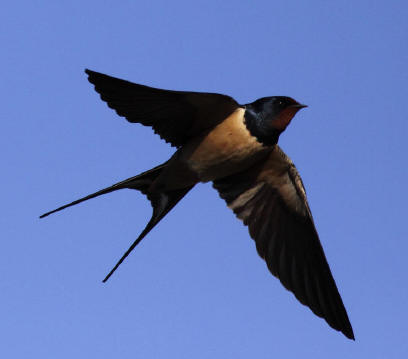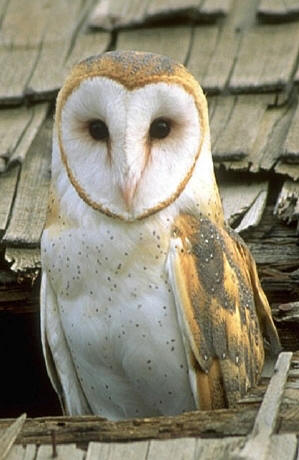The Barn Birds of the Mason Dixon Area
Rusty Ryan
Conservation Chairperson of the South Mountain Chapter
of the National Audubon Society
(7/2012) The Mason Dixon area supports two barn birds, the Barn Swallow and the Barn Owl. The Barn Swallow is considered abundant and the Barn Owl is uncommon. Both species are the most widely distributed
of their kind (swallows and owls) in the world.
The Barn Swallow
 Have you ever heard the saying: Were you born in a barn? This question is often asked when someone feels a draft due to somebody forgetting to
close a door behind them. Well in the case of both of these birds, leaving the barn doors open leads to the success of these unique predators and beneficial friend to humans.
Have you ever heard the saying: Were you born in a barn? This question is often asked when someone feels a draft due to somebody forgetting to
close a door behind them. Well in the case of both of these birds, leaving the barn doors open leads to the success of these unique predators and beneficial friend to humans.
The Barn Swallow is the most widespread and numerous swallow species in the world. It is a neo-tropical migrant which means this bird winters in the southern hemisphere but migrates north each spring to
breed in North America. The Barn Swallow usually arrives to the Mason-Dixon area by April, breeds and leaves the area by August.
The Barn Swallow is easily recognized from the other swallow species by having a deeply forked tail. This swallow is about the size of a slim bluebird and has a habit of flying very low over fields in
search of flying insects. These aerial feeders are the swallow specie most likely to be foraging for food by following the farmer or property owner when mowing.
As the name implies, this swallow is fond of nesting in barns. I suppose that this species has adapted over time to prefer barns due to these structures having flight access into and out of barns. The
nest is usually cup shaped and attached directly to the beams and eaves. The necessary nesting materials needed to construct the nest can be found nearby. The necessary nesting materials consist of mud and straw (horsehair is
often used). The Barn Swallow produces saliva which is mixed with the mud to make pellets which the bird will fly back and use to make nest. The Barn Swallow like the Purple Martin does return to the same nesting site each year.
The Mason Dixon area supports 5 other species of swallows. They are the Purple Martin, Tree Swallow, Rough-winged Swallow, Bank Swallow and Cliff Swallow.
Besides the Barn Swallow, the Purple Martin and Tree Swallow use artificial nesting provide by humans. The Tree Swallow readily accepts the standard bluebird box if placed in the appropriate location and
the Purple Martin almost exclusively relies on artificial nesting. Note: In the March 2010 edition of the Emmetsburg Journal, I wrote an article on becoming a landlord for Purple Martins, the Mason-Dixon area largest swallow
species.
So if you live in the country and have outbuildings that are accessible than you have a good chance of attracting this swallow. So don’t forget to leave the doors open in the spring and summer in hopes of
coaxing this swallow to raise young. Who knows, you may just have the right property to entice the Tree Swallow, Barn Swallow and Purple Martin. Your neighbors should be envious of the lack of nuisance insects during those
afternoon picnics when there swallows are busy devouring insects.
The Barn Owl (the monkey-faced owl, ghost owl)
 The Barn Owl is a long legged owl a bit larger than a crow. It has a distinct white heart shaped facial disk and vocally sounds nothing like the
hoot owls such as the locally common Great Horned Owl and Barred Owl.
The Barn Owl is a long legged owl a bit larger than a crow. It has a distinct white heart shaped facial disk and vocally sounds nothing like the
hoot owls such as the locally common Great Horned Owl and Barred Owl.
The preferred habitat is open grassy fields. They are nocturnal and the unique facial disk allows this owl to hunt in complete darkness by relying on just sound.
If you’re a farmer and mice are causing you problems than having the Barn Owl around is just the ticket for controlling these rodents. It has been said that the Barn Owl is the world’s best mouse catcher.
According to literature from the Maryland Cooperative Extension (FACT Sheet 795), the value of the Barn Owl to a farmer is unrivaled. During the average lifespan of 10 years, it is estimated that one owl will consume 11,000
mice. These 11,000 mice could consume/contaminate an average of 13 tons of grain, seed and growing crops in their lifetime. Sounds like a no brainer for the farmer. The typical barn cat cannot rival the barn owl when it comes to
being the better "mouser".
Besides barns, hollow trees, bridges and other structures, the Barn Owl will utilize artificial nesting structures. Some property owners are not too keen on having Barn Owls have free reign to their barn
due to the messy excrement left behind on their farm implements. In order for both man and bird to co-exist, nest boxes can be constructed and attached to the barn with its own private entrance.
True story: Twenty years ago a friend approached me about placing an artificial barn owl box in his silo. The silo had no top so we suspended the box on the interior of the silo and within days a pair of
Barn Owls took residence. For the past twenty years, Barn Owls have raised young in the man made box. Humans can make a difference.
So if you’re a fortunate property owner who resides in rural areas surrounded by grassy acreage you should be able to attract both barn birds who will keep those pesky insects and rodents under control
the organic way.
Useful web sites:
- www.allaboutbirds.org
- http://www.americanartifacts.com/smma/per/birds.htm
- www.owlpages.com
- http://extension.umd.edu/publications/pdfs/fs795.pdf
- http://www.barnowlbox.com/barn-owl-biology.html